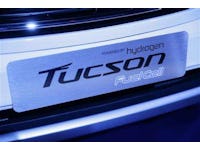National electric vehicle strategies strongly diverge
Jul 02, 2015

They cannot all be right. Korea and its flagship company Hyundai strongly back fuel cell vehicles, just like the Japanese with Toyota and Honda strongly in pursuit. Hyundai introduced its hydrogen-powered Tucson SUV in the US in 2014, the world's first mass-produced fuel-cell car, then came the Toyota Mirai this year. The Germans remain keen but, at the recent EVS28 event in Seoul Korea, the Daimler message had moderated to welcoming a hearty contest at the heavy end between the pure electric battery option and fuel cell.
By contrast, the Chinese government has recently focussed almost entirely on an end point of pure electric vehicles. Even the largest vehicles such as double decker buses and articulated buses are now selling strongly in battery-only form aided by huge government subsidies. In the USA, Tesla and others deride the end point portrayed by Toyota and Honda of large and heavy duty vehicles having fuel cells with hydrogen made from solar panel electricity and converted back to electricity again to drive the vehicle: straight to a battery is much more efficient and green they argue. But will the batteries, or some say the emerging lithium-ion capacitors, be cost effective when grants melt away? The IDTechEx reports on supercapacitors explore those aspects at www.idtechex.com  .
.
The main battle ground could well become the larger vehicles. The industrial and commercial electric vehicle business will be 42% of the EV market in 2025 on IDTechEx analysis with well over 50% of the profits because so much of it is specialist and niche and the vehicles are not bought on up-front price. See the unique IDTechEx report, Industrial and Commercial Hybrid and Pure Electric Vehicles 2015-2025. Indeed, so far, the only success in selling traction fuel cells for vehicles without financial support is for industrial forklifts in the USA.
A fuel cell produces one kilowatt of heat for every kilowatt of electricity and that is elegantly employed in the successful Micro CHP (combined heat and power) units for remote houses and the like. The remains of the United Technologies Corp. and ClearEdge Power fuel cell operations, once partly aimed at vehicles, were mopped up by South Korea's Doosan Corp which combined them with Fuel Cell Power Inc., a company it purchased. However, the merged operation, Doosan Fuel Cell America, produces large, stationary systems for industrial and commercial uses. Six of its systems are running in a Seoul suburb, providing 2.6 megawatts of capacity to the local power grid. Vehicles are no longer a focus.
However, in the UK, a country with a "half-pregnant" approach to fuel cell vehicles, has Proton Motor Fuel Cell registered there and Intelligent Energy operating there and they are definitely making progress with fuel cells for vehicles, including small ones such as scooters, these being a focus of a major program in Taiwan as well. This is detailed in the new IDTechEx report, Fuel Cell Electric Vehicles 2015-2030: Land, Water, Air.
Top image source: Jae C. Hong